

For some years when I was growing up, we lived in a small apartment building in our bustling little town in the South of India. Those were some really wonderful times. My best friend and classmate lived close by and we would often walk back together from school and hang out after home work, chattering on the terrace, until the sun began to set behind the far away hills. There were only about fifteen other families living in the building complex. Everyone knew each other, the kids were always in and out of each other's homes and our mothers (we addressed each other's moms respectfully and affectionately as "Aunty") would lean out of their balconies to carry on long conversations with each other, enjoying gossip and heated discussions along with the cool evening breeze.
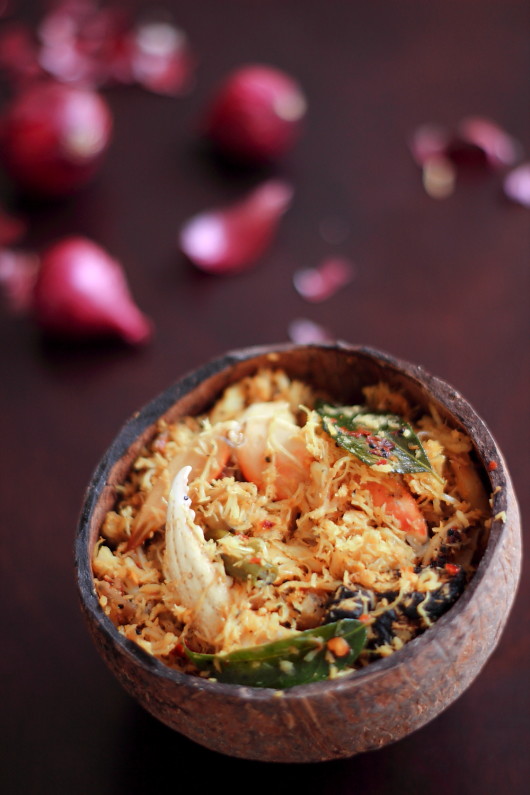
But early every Tuesday morning, something seemed to happen to those normally warm and friendly ladies. On those same balconies, battle lines were drawn and friendships were momentarily put aside. Because it was on Tuesday mornings that the fishmonger would arrive, very conveniently right up to the doorstep of the building- his prized supplies in a large icebox, which was precariously tied to the back of his rickety moped. The contents of that ice box was a matter of much contention among the ladies because in those days, ( and I hear things haven't changed much even with the many large supermarkets chains everywhere) finding good, fresh fish if you missed the fishmonger, meant a tiring and often frustrating trip to the crowded and smelly fish market. I have been told that the novelty of wading though narrow, crowded paths and bargaining over the various types of fish on offer, quickly waned, and everyone but the most determined relied on the neighbourhood fishmonger for their seafood supply.

The fishmonger announced his arrival both with the deafening rattling of his bike as well as his loud familiar sing-song, citing the catch of the day "Mathi, Aiyla, Neimeeen--ooooi!" (not quite like this guy who has a whole routine going!) Immediately all the women would peer out from their balconies or rush downstairs to haggle over his sardines, mackerel, seer-fish or the rare treats like the prized Karimeen (Pearl spot), shrimp, anchovies or the small crabs. Opinions and offers flew fast and thick from the buyers perched on their respective balcony or crowded around that ice box below, and deals were struck like lightning.
I don't know how she did it, but my mild-mannered, soft-spoken mom managed to place dibs on crab quite frequently, even though some of our neighbors were pretty tough cookies. If she did score crab that day she would beam triumphantly and immediately disappear into the kitchen to begin cooking.
She would usually make it the same way each time. Cracking open the shell and pulling out the flesh from even the tiny legs to make it easier for us (spoilt) kids so that we wouldn't bite into bits of shell, and cooking the flesh in very little warm water in which sour Kokum was soaked. The water was evaporated to ensure that every bit of the tanginess was absorbed by the crab, usually in a wide, shallow clay pot ( mann chatti) reserved for cooking seafood, that also imparted it's rustic earthiness.
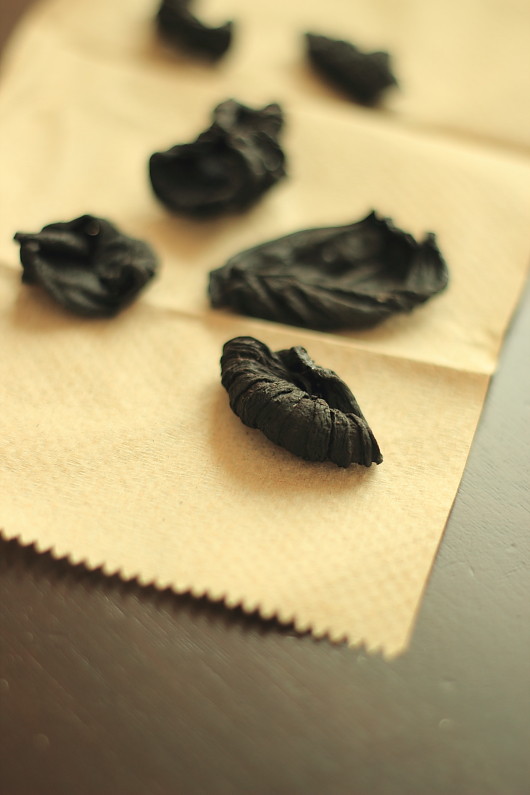 |
| Kokum- used like tamarind to impart sourness usually in seafood dishes |
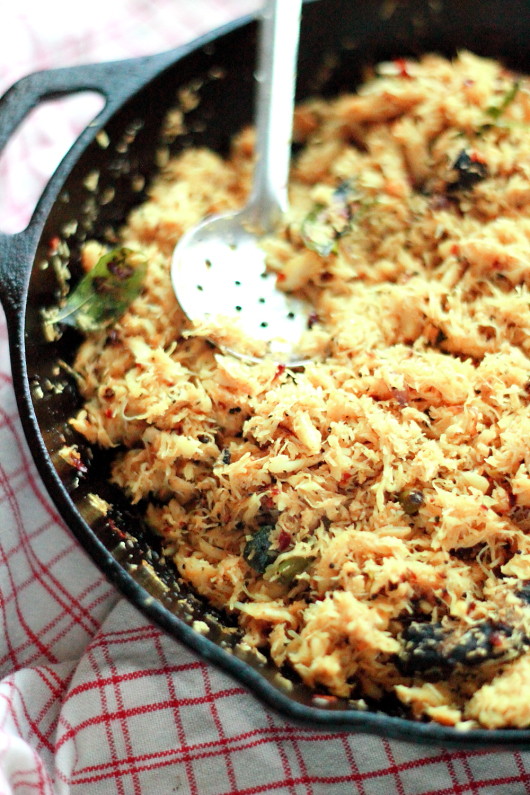
This process of cooking is termed Pattichathu, where delicate seafood is cooked in a little amount of flavorful liquid until all the liquid is absorbed and evaporated. She then stirred the tender meat gently, along with coconut, tempered spices and curry leaves over a low flame so that the flavours danced together harmoniously.
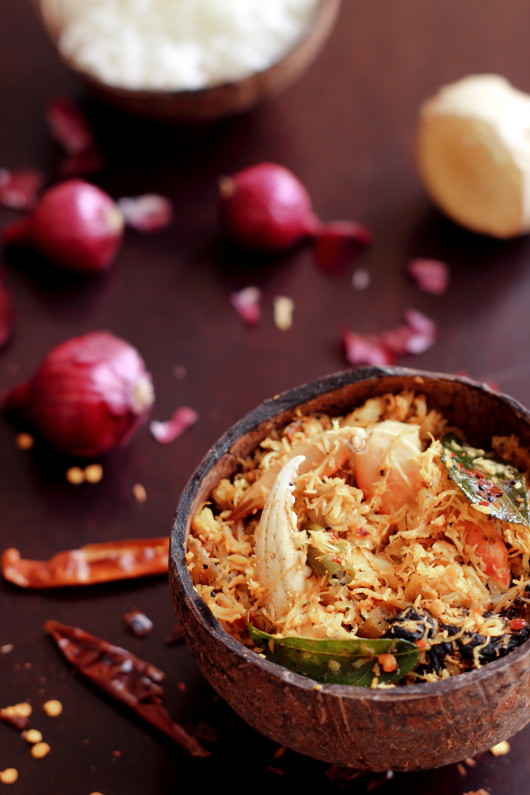
When I saw crabs at my neighborhood grocery store I was suddenly filled with all the memories surrounding my mom's crab dish and a deep craving for it, so I immediately decided to make it. Halfway through wheedling the flesh out of one crab and my hands were scraped red. I decided I didn't have to do everything exactly like my mom did, and left the rest of the flesh intact to crack open at the dinner table, which was actually kind of fun! The rest of the process is quite simple and you can make this with any kind of fish by flaking the meat, and is especially delicious with tiny shrimp. It is also one of the most magical things you can do to a can of tuna, along with this, although of-course it is most excellent with crab.
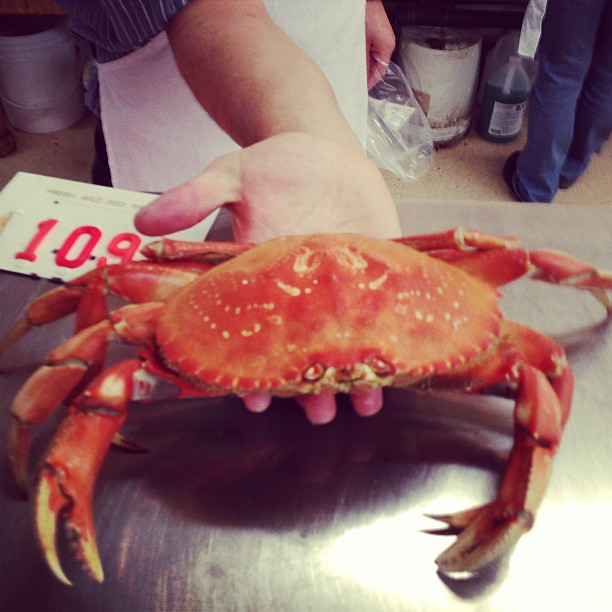
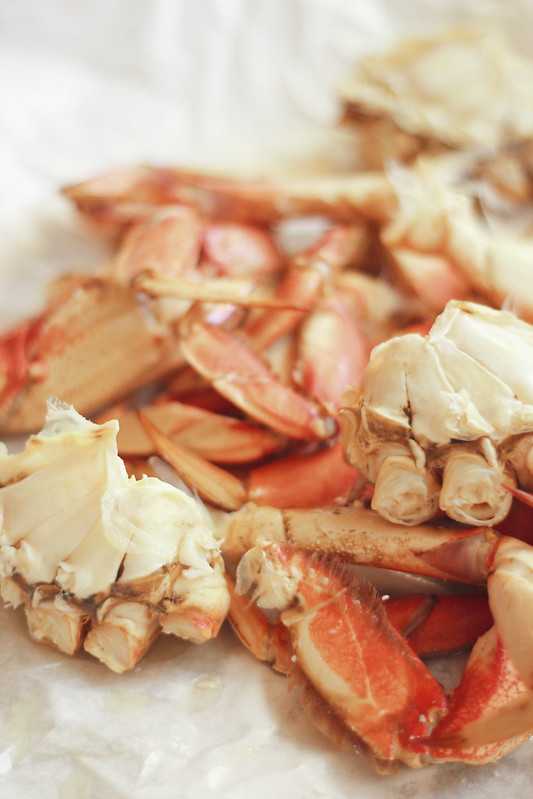
We ate it with mounds of rice and a little spiced buttermilk and the tantalizing play of contrasting flavours - the sweet crab meat and coconut, tang from the Kokum, the zing of freshly grated ginger, heat of the green chillies with the crunchy toasted mustard seeds is something you will never forget.

A new friend, the very lovely Jean from Lemon and Anchovies had been cooking with crab too, and I couldn't wait to see what she would make with it, especially since she mentioned homemade pasta and fried Meyer Lemons! To see what Jean made with her crabs go to her beautiful blog here. Isn't it great how one ingredient can be cooked in so many delightfully different ways? Never ceases to amaze!
Njandu Peera Pattichathu ( Crab Shredded and Poached)
Ingredients
- Crab meat -1 pound or 500 gms of meat
- Kokum ( Kodampuli) – 3 pieces ( A kind of tamarind, available in Indian stores, else substitute with a marble sized ball of regular tamarind, if you can't find either, just squeeze some lemon before serving for some tang)
- Turmeric powder – 1/4 teaspoon
- Red chili powder – 1/2 tablespoon
- Grated coconut – 1 cup ( If using frozen shredded coconut like I do, thaw for about a minute in the microwave)
- Fresh ginger, peeled and grated – About an inch (Do not use store bought ginger paste instead, omit it if you have to)
- Thai green chillies slit in half – 6-10
- Warm water for poaching the crab and soaking Kokum- 1 cup for fresh crab (1/4 cup if using cooked crab)
Also if you are not used to spicy food, please reduce amount of red chilli powder and green chillies to suit your tastes
For the tempering:
- Coconut oil – 1-2 tbsp
- Mustard seeds - 1 tsp
- Cumin seeds- 1/4 tsp
- Garlic pods, each sliced in half – 8
- Small Pearl onions or Shallots– 3-4 (sliced thin or use half of a red onion instead chopped fine)
- Dried Red chillies – 3 ( or 1 tsp red chilli flakes)
- Curry leaves- 8 ( Optional, avaliable in Indian grocery stores. Do not substitute with curry powder)
- Sprinkle salt to taste
If you are using uncooked crab meat, soak the Kokum in about a cup of warm water in a pot or saucepan ( but preferably an earthernware mann chatti). If you are using already cooked crab use less water, only about 1/4 cup, just enough to cover the Kokum pieces in a small cup.Soak the Kokum until it softens and the water turns a brown colour- about 15 minsNow add all the ingredients including crab meat with the kokum water and stir gently together- just to flake up the flesh a little. Turn on the heat to a medium and bring the liquid to a gentle boil.Cook, stirring very occasionally till all the water has evaporatedIn a separate pan or skillet, heat the coconut oil and just before it begins to smoke, add the mustard seeds and wait for all of them to finish popping. Cover with a lid to prevent the seeds from popping all over your kitchen!Once it begins to slow down to just a few pops, add the cumin and stir until it turns brown and no longer smells raw. Careful not to burn or blacken them.Add the garlic and lightly brown it, then the onions and golden brown them too. Add the chilli powder and curry leaves together and switch off the heat just as curry leaves begin to stiffen up. Now add the crab mixture to the tempering in the pan, salt to taste, and stir gently on low heat until the dish is completely dry and flavours are well combined. Enjoy with rice and spiced buttermilk ( recipe follows) Tastes best the day it's made.
For the spiced buttermilk1 cup yogurt1 cup water3-4 fresh thai green chillies choppedsalt to taste.
Stir in a little water at a time into the yogurt whisking with a spoon constantly to make buttermilk ( or just use store bought buttermilk- which is usually a little more hard to find than yogurt) Stir in the green chillies and enough salt to taste Serve chilled or at room temperature, pouring over rice or drinking as is.
Although traditionally served with rice, I think this crab dish also tastes great with salad and a soft boiled egg. Even though this dish may sound complicated, the part that will take the longest is the shelling of the crab, and you can just use crab meat instead or even most white, flaky fish as mentioned above. Everything else is quite easy.
However if you still think there are too many components, you will be happy to read about a very easy recipe that I will post soon, for a simpler and very quick way to enjoy crab. Stay tuned! Tweet
Hiç yorum yok:
Yorum Gönder